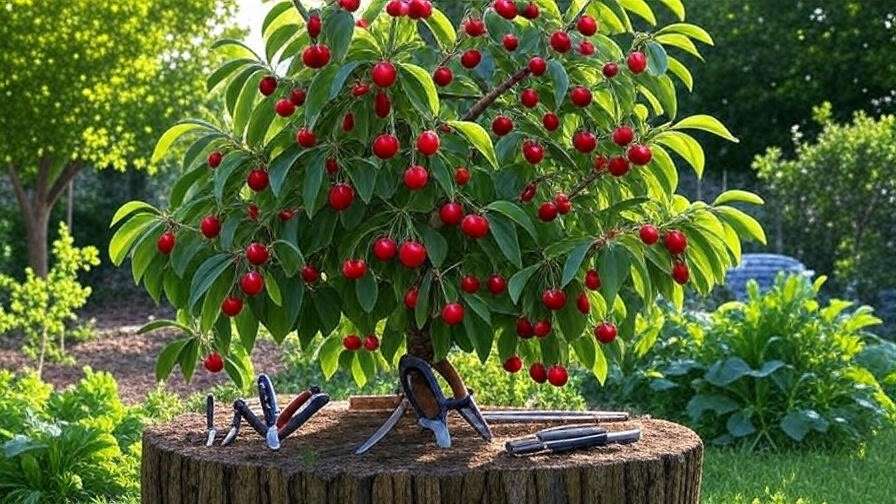Want to turn your cherry trees into a bountiful orchard bursting with juicy, flavorful fruit? The secret lies in mastering the art and science of pruning fruiting cherry trees. Whether you’re a novice gardener or a seasoned orchardist, proper pruning can transform your trees, boosting yields by up to 25% and ensuring vibrant health. This comprehensive guide dives deep into expert techniques, practical tips, and science-backed strategies to help you prune with confidence. From understanding cherry tree biology to avoiding common mistakes, we’ve got you covered with everything you need to grow your best harvest yet. Let’s get started!
Why Pruning Fruiting Cherry Trees Is Essential 🍒
Pruning isn’t just a chore—it’s a game-changer for your cherry trees. By strategically trimming branches, you unlock a host of benefits that directly impact fruit quality and tree longevity. Let’s explore why pruning is non-negotiable for a thriving orchard.
Benefits of Strategic Pruning
Pruning fruiting cherry trees enhances fruit size, flavor, and quantity by optimizing sunlight exposure and air circulation. Open canopies allow light to reach inner branches, boosting photosynthesis and encouraging larger, sweeter cherries. Improved airflow reduces humidity, lowering the risk of fungal diseases like powdery mildew. Pruning also promotes a strong tree structure, ensuring branches can support heavy fruit loads without snapping. According to research from Michigan State University’s Extension, well-pruned cherry trees can yield 20-30% more fruit compared to unpruned ones, making it a critical practice for maximizing productivity.
Consequences of Skipping Pruning
Neglecting pruning invites trouble. Dense canopies block sunlight, leading to smaller, less flavorful cherries and increased pest issues like aphids or scale. Overcrowded branches create weak points that may break under the weight of a heavy harvest, damaging the tree. A real-world example from a Washington orchardist illustrates this: a neglected sour cherry tree produced only 10 pounds of fruit annually, while a pruned counterpart yielded over 30 pounds. Unpruned trees also face higher disease risks, such as bacterial canker, which thrives in poorly ventilated canopies. Regular pruning keeps your trees healthy and productive.
The Science Behind Cherry Tree Growth 🌿
To prune effectively, you need to understand how cherry trees grow and produce fruit. This knowledge ensures your cuts support the tree’s natural tendencies, leading to better harvests.
How Cherry Trees Produce Fruit
Cherry trees, whether sweet (Prunus avium) or sour (Prunus cerasus), rely on fruiting spurs—short, stubby growths that produce flowers and fruit. Sweet cherries grow on larger trees with upright habits, while sour cherries tend to be bushier and more compact. Both types develop vegetative buds for new branches and fruiting buds for cherries. Pruning influences how the tree allocates energy between vegetative growth (leaves and branches) and fruit production. By removing excess growth, you direct energy to fruiting spurs, enhancing yield and quality.
Optimal Timing for Pruning ⏰
The best time to prune cherry trees is during the dormant season—late winter to early spring (February to March in most climates). Pruning during dormancy minimizes disease risk, as pathogens like bacterial canker are less active. It also allows you to see the tree’s structure clearly without leaves. Light summer pruning (late June to early July) can control vigor or shape young trees but should be minimal to avoid stress. For gardeners in warmer climates (e.g., USDA Zone 8), adjust timing to avoid late frosts. Use this schedule:
- Zone 5-6: Late February to early March.
- Zone 7-8: Early February or post-frost.
Preparing for Pruning: Tools and Safety 🛠️
Proper tools and preparation set the stage for successful pruning. Using the right equipment and following safety protocols ensures clean cuts and protects both you and your trees.
Must-Have Pruning Tools
Invest in quality tools for precise, clean cuts:
- Bypass Pruners: Ideal for small branches (up to ¾ inch).
- Loppers: Handle thicker branches (up to 1.5 inches).
- Pruning Saws: For larger branches (over 1.5 inches).
- Pole Pruners: Reach high branches on tall sweet cherry trees.
Sterilize tools with 70% isopropyl alcohol before and after pruning to prevent diseases like bacterial canker. Brands like Felco, Corona, or ARS offer durable, sharp tools trusted by professionals. A sharp blade ensures clean cuts that heal quickly, reducing infection risk.
Safety and Setup Best Practices
Pruning involves sharp tools and heights, so prioritize safety:
- Wear gloves, safety glasses, and sturdy shoes to protect against cuts and falling debris.
- Use a stable, well-positioned ladder for taller trees, ensuring it’s on firm ground.
- Before pruning, inspect your tree for signs of disease (e.g., oozing sap) or structural issues. Plan your cuts to avoid removing more than 25% of the canopy in one session. Sharpen tools beforehand—dull blades tear wood, slowing healing.
Step-by-Step Pruning Guide for Cherry Trees ✂️
Follow this detailed guide to prune your cherry trees like a pro. Each step builds on the last, ensuring a healthy, productive tree.
Step 1: Evaluate Your Tree’s Structure
Start by assessing your tree’s health and shape. Look for the “3 Ds”: dead, diseased, or damaged branches. Dead branches are brittle and lack buds, while diseased ones may show discoloration or gummosis (sap leakage). Check canopy density—too many branches block sunlight, reducing fruit quality. Take photos to compare before and after pruning, helping you track progress. A well-structured cherry tree should have an open canopy with evenly spaced branches.
Step 2: Remove Problem Branches
Begin pruning by removing:
- Suckers: Shoots growing from the base or roots.
- Water Sprouts: Vigorous, upright shoots in the canopy.
- Crossing Branches: Branches rubbing against each other, causing wounds.
Make clean cuts at a 45-degree angle just outside the branch collar (the swollen area where the branch meets the trunk). Avoid leaving stubs, as they invite pests and disease. For larger branches, use the three-cut method to prevent bark tearing:
- Cut halfway through the branch underside, 6 inches from the collar.
- Cut fully through 2 inches farther out.
- Remove the stub with a final cut at the collar.
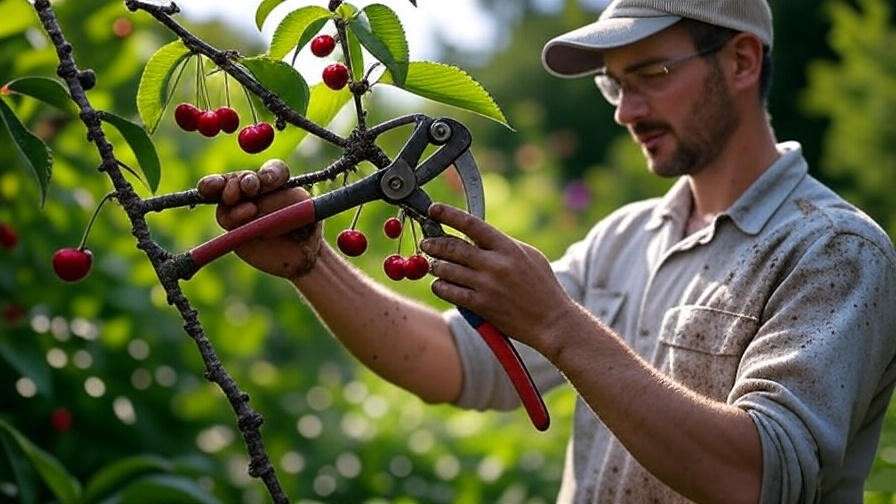
Step 3: Shape for Maximum Fruit Production
Choose a pruning system based on your tree type:
- Open-Center (Vase-Shaped): Ideal for sour cherries, creating a wide, open canopy for sunlight.
- Central-Leader: Best for sweet cherries, maintaining a strong central trunk with tiered branches.
Thin fruiting spurs to prevent overbearing, which leads to small fruit. Remove one-third of older spurs (over 3 years old) to encourage new ones. Aim for 4-6 strong scaffold branches spaced evenly around the trunk. A diagram showing an ideal open-center structure can help visualize this step.
Step 4: Maintain Mature Cherry Trees
For mature trees, annual maintenance pruning keeps the canopy open and productive. Remove 10-15% of older wood to stimulate new growth. Balance fruiting spurs with vegetative branches to avoid exhausting the tree. Avoid heavy pruning—removing more than 25% of the canopy can shock the tree, reducing yields for 1-2 seasons. Check for weak or overcrowded branches annually and adjust as needed.
Step 5: Post-Pruning Care
After pruning, support your tree’s recovery:
- Sealants: Use sparingly, only on large cuts in disease-prone areas, as most cuts heal naturally.
- Fertilizer: Apply a balanced 10-10-10 fertilizer in early spring to boost growth.
- Mulch: Add 2-3 inches of organic mulch (e.g., wood chips) around the base, keeping it 6 inches from the trunk.
Monitor for stress signs like wilting leaves or excessive sap. Water deeply if pruning during dry periods.
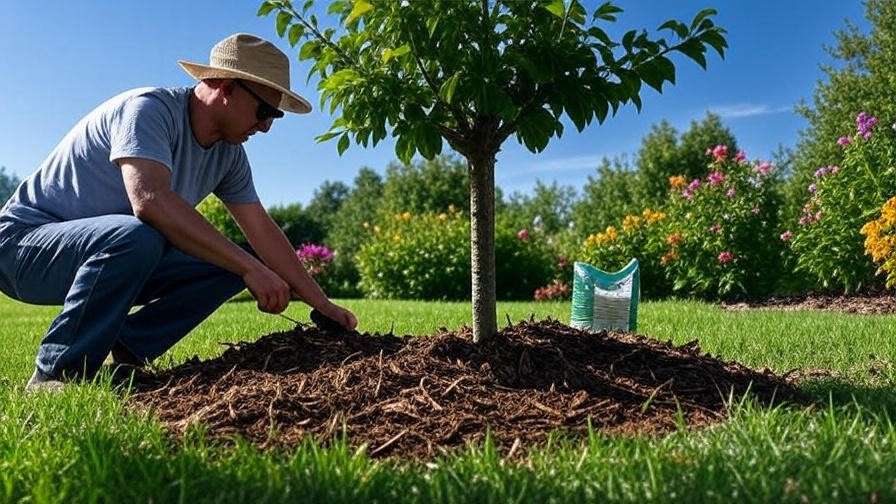
Common Pruning Mistakes and How to Avoid Them 🚫
Even experienced gardeners can make pruning errors that harm cherry trees. Avoiding these pitfalls ensures your pruning efforts enhance rather than hinder your harvest. Here are the most common mistakes and how to steer clear of them:
- Over-Pruning: Removing too much foliage—more than 25% of the canopy—can shock the tree, reducing fruit production for one or more seasons. To avoid this, plan cuts carefully and spread major pruning over multiple years for older trees. Always prioritize gradual thinning over drastic cuts.
- Wrong Timing: Pruning during active growth (late spring or summer) or during freezing conditions increases disease risk and stresses the tree. Stick to the dormant season (late winter to early spring) for most cuts, using summer pruning only for light shaping. Check local weather patterns to avoid frost damage post-pruning.
- Improper Cuts: Jagged cuts, flush cuts, or leaving stubs can invite pests and pathogens. Use sharp tools and cut at a 45-degree angle just outside the branch collar. For example, a gardener in Oregon learned this the hard way when flush cuts led to bacterial canker in their sweet cherry tree. Practice proper technique with small branches first to build confidence.
- Ignoring Tree Health: Pruning a stressed or diseased tree can worsen its condition. Before pruning, inspect for signs of distress like gummosis (sap leakage) or wilting leaves. Address underlying issues, such as poor drainage or nutrient deficiencies, before making cuts.
Tip: Keep a pruning journal to track what you cut, when, and the tree’s response. This helps identify patterns and avoid repeating mistakes.
Tailoring Pruning to Cherry Tree Varieties 🍒
Different cherry tree varieties have unique growth habits, requiring tailored pruning approaches. Understanding these differences ensures optimal fruit production and tree health.
Pruning Sweet Cherry Trees
Sweet cherry trees, like Bing, Rainier, or Stella, grow taller (15-25 feet) and have an upright structure. Pruning focuses on managing height and creating an open canopy. Use a central-leader system, maintaining a strong central trunk with 4-6 scaffold branches spaced evenly. Remove vigorous upright shoots to prevent shading and thin fruiting spurs to avoid overbearing. For taller trees, use pole pruners to reach high branches safely. Regular pruning keeps harvesting manageable and ensures sunlight reaches lower branches for consistent fruiting.
Pruning Sour Cherry Trees
Sour cherries, such as Montmorency or Morello, are smaller (8-15 feet) and bushier, with a spreading growth habit. An open-center (vase-shaped) system works best, creating a wide canopy for sunlight penetration. Thin crowded branches to maintain airflow, as sour cherries are prone to fungal issues in humid conditions. Focus on removing older fruiting spurs to encourage new growth, as sour cherries produce heavily on 2-3-year-old wood. These trees require less aggressive pruning than sweet cherries but benefit from annual maintenance to prevent overcrowding.
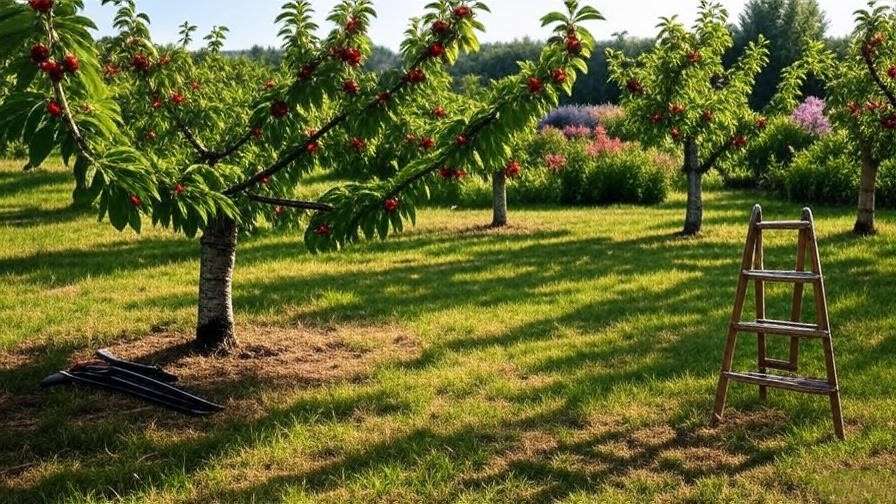
Pruning Dwarf and Semi-Dwarf Cherry Trees
Dwarf and semi-dwarf varieties, like Stella Compact or Gisela-rootstock trees, are ideal for small gardens or containers, growing 6-12 feet tall. Pruning focuses on maintaining a compact shape while maximizing fruit yield. Use an open-center system and thin branches to ensure sunlight reaches all parts of the canopy. Avoid heavy pruning, as these trees have less wood to spare. Regular spur thinning prevents overbearing, which can stunt small trees. For container-grown dwarfs, prune lightly twice a year (dormant season and early summer) to control size.
Advanced Pruning Techniques for Expert Gardeners 🌟
For seasoned orchardists looking to elevate their pruning game, these advanced techniques can enhance both aesthetics and productivity:
- Espalier Pruning: Train cherry trees against a wall or trellis for ornamental appeal or space-saving in small gardens. This involves tying branches to a framework and pruning to maintain a flat, two-dimensional shape. Sweet cherry dwarfs work best for espalier. Regularly remove vertical shoots and maintain horizontal branches for fruit production.
- Rejuvenation Pruning: Revive old or neglected cherry trees by gradually removing up to one-third of old wood over 2-3 years. Focus on dead or unproductive branches, encouraging new growth. A 2019 study by the Royal Horticultural Society found rejuvenation pruning increased yields by 15% in neglected sour cherry trees.
- Training Young Trees: For newly planted cherry trees, establish a strong structure early. Select 3-5 scaffold branches in the first year and remove competing leaders. Pinch back vigorous shoots to encourage branching. This sets the foundation for a productive tree.
Expert Insight: Consult local extension services for region-specific advice on advanced techniques, as climate and soil conditions impact pruning outcomes.
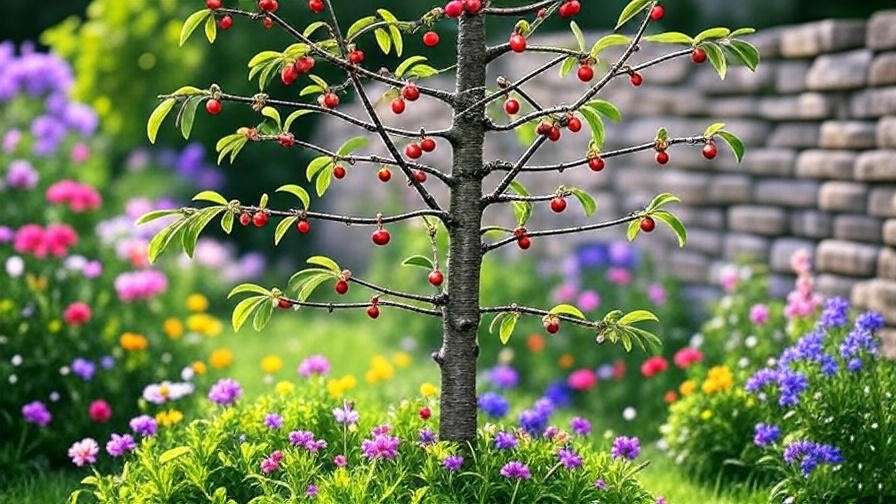
Troubleshooting Post-Pruning Problems 🩺
Pruning can occasionally trigger issues, especially if done incorrectly. Here’s how to identify and address common problems:
- Gummosis or Bacterial Canker: Sap leakage or dark lesions near cuts may indicate disease. Sterilize tools between cuts and remove affected branches 6 inches below symptoms. Apply a copper-based fungicide if canker is confirmed.
- Pest Infestations: Fresh cuts can attract pests like borers or aphids. Monitor for sawdust-like frass (borer sign) or sticky leaves (aphids). Use neem oil or insecticidal soap for minor infestations.
- Tree Stress: Wilting leaves or stunted growth post-pruning suggest stress. Ensure adequate water (1 inch per week) and avoid fertilizing immediately after heavy pruning.
Quick-Reference Table:
| Symptom | Possible Cause | Solution |
| Sap leakage | Gummosis/Canker | Remove affected wood, sterilize tools |
| Sticky leaves | Aphids | Apply neem oil, encourage ladybugs |
| Wilting | Stress/Over-pruning | Water deeply, monitor recovery |

If problems persist, consult a certified arborist through your local extension service.
FAQs About Pruning Fruiting Cherry Trees ❓
Here are answers to common questions gardeners ask about pruning cherry trees:
- How often should I prune my cherry tree?
Prune annually during the dormant season for maintenance. Young trees may need light summer pruning to shape growth. - Is summer pruning safe for cherry trees?
Yes, but limit it to minor cuts for shaping or removing water sprouts. Heavy summer pruning risks disease and stress. - How do sweet and sour cherry pruning needs differ?
Sweet cherries need height management and a central-leader system, while sour cherries benefit from an open-center system and less aggressive cuts. - What are signs I’ve over-pruned my tree?
Wilting, sparse foliage, or reduced fruiting indicate over-pruning. Allow the tree to recover for a season before pruning again. - Do dwarf cherry trees require unique pruning methods?
Dwarf trees need lighter pruning to maintain their compact size, focusing on spur thinning and canopy openness.
Further Resources for Cherry Tree Success 📚
Deepen your knowledge with these trusted resources:
- Books: “The Pruning Book” by Lee Reich or “Grow a Little Fruit Tree” by Ann Ralph.
- Websites: University extension sites like Cornell, WSU, or UC Davis for region-specific guides.
- Workshops: Check with local agricultural extensions for pruning classes or orchard tours.
Downloadable Resource: Create a free pruning checklist tailored to cherry trees, covering timing, tools, and steps.
Conclusion: Grow Your Best Cherry Harvest Yet 🌸
Pruning fruiting cherry trees is the cornerstone of a thriving orchard, unlocking larger harvests, healthier trees, and vibrant fruit. By following this guide’s step-by-step techniques—rooted in decades of horticultural research—you can prune with confidence and avoid common pitfalls. Start small, observe your trees’ responses, and refine your skills each season. Ready to see your cherry trees flourish? Grab your pruners and apply these tips this dormant season. Share your pruning success stories in the comments or on gardening forums to inspire others!

